These days, when it rains, it really pours. Due to global climate change, “Heavy downpours are increasing nationally,” noted the National Climate Assessment’s 2014 report, compiled by hundreds of experts overseen by a 60-member federal advisory committee. And in the Southeast, rain intensity has increased nearly 30 percent in recent decades, the report concluded.
Here in Asheville, however, climate change is only one factor driving a rising tide of stormwater problems. Aging infrastructure and rapid rates of development are exacerbating the weather issues. And meanwhile, longtime residents in many parts of town say some streets, yards and basements that had never experienced flooding before are now turning into raging rivers or roiling pools with frightening regularity.
But addressing Asheville’s stormwater challenges won’t be easy, cheap or quick. The annual capital budget for fixing these problems — roughly $1.1 million to $2.3 million, financed by stormwater fees paid as part of property owners’ water bills — doesn’t come close to meeting the needs.
“We do include money in the budget every year for stormwater fixes, but it’s probably not nearly enough,” says City Council member Julie Mayfield, who ranks the issue among the most pressing challenges the city faces.
Boundary issues
Part of the difficulty of dealing with stormwater problems, says Assistant City Manager Cathy Ball, stems from the complex mix of ownership of the various pipes, culverts, ditches and drains involved, as well as the finer points of where the city’s responsibility ends and private property owners’ begins.
“The reason cities got into the stormwater business in the first place was to make roads safe and passable,” Ball explains. For the most part, cities are on the hook for keeping roadways clear of water; other concerns — including erosion, flooding on private property and underground drainage pipes residents may not even know they own — fall outside the public realm.
Yet even looking solely at city-owned rights of way, says Ball, “The fees we collect are not enough to really improve that infrastructure to the extent where we aren’t having some problems.”

In the proposed budget for the 2017-18 fiscal year, which begins July 1, the Finance Department projects total stormwater fee revenue of $5.6 million, reflecting a 5 percent increase in stormwater rates passed by Council in March. The Stormwater Services Division plans to spend roughly one-third of that revenue — $1.83 million — on capital improvements, such as installing about 2,000 feet of pipe. City Council is expected to approve a budget on June 13.
But for Mayfield, who’s also co-director of the environmental nonprofit MountainTrue, adhering to the strictest legal interpretation of the city’s responsibilities doesn’t pass the smell test.
“If a citizen bought a house and there is an old pipe that’s not working anymore … these projects are tens of thousands of dollars,” she points out, adding, “They’re not things that homeowners plan to spend money on.”
Providing systems for safely diverting rainwater into streams and rivers while protecting private property and downstream water quality, Mayfield maintains, is “part of our job as a city.”
At the same time, she concedes, “That would commit the city to millions and millions more dollars.” Nonetheless, she says, really getting to the root of the problems will require including structures located on private property.
Inundated
During the public comment portion of a City Council meeting last June, neighbors of West Asheville’s Hall Fletcher Elementary School gave Council members an earful, spelling out how stormwater problems have tormented their community.
Jeanne Felknor, who lives at 140 Wellington St., painted a vivid picture with photos and words. “Just on a regular rain, we have whitecaps,” she explained. And, evoking the canals of Venice, Felknor added, “You could take the gondola down the street.” She also showed a photo of water standing in her basement.
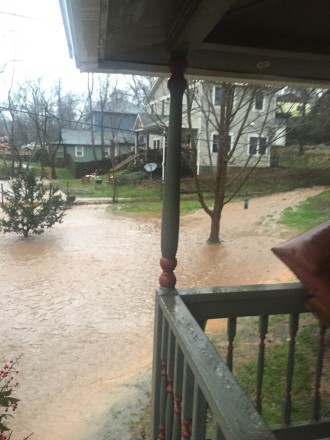
Yet when residents asked city staff for help, said Nina Hart of 166 Wellington St., they were told, “Each affected resident would have to pull a permit and be required to pay the Corps of Engineers to dictate a plan that would include the involvement of private engineers that we would have to pay for as well.” Staff, continued Hart, said, “Each resident involved could end up spending around $30,000 for water mitigation, while the city was not responsible.”
In 2004, Tadd Clarkson bought a home at 25 Longview Road, above Hall Fletcher Elementary. He knew that water from the street sometimes flowed into the front yard, and he invested time and money on measures to divert the water “with some success,” he said. But in the summer of 2012, city crews installed a new curb a few houses away from Clarkson’s property.
“When that curb was put in, the water coming down the street and down my yard increased exponentially,” overwhelming his previous fixes, noted Clarkson. Over a period of years, he’s sought assistance from various city agencies, including Public Works and Stormwater Services, without getting any relief.
Other neighbors said a curb installed at Hall-Fletcher Elementary in 2015 had exacerbated the problems on Wellington Street, as has new development in the area.
“We need amazing stormwater engineers to take this on,” former Wellington Street resident Miriam Allen observed.
Holistic fixes
“The only way to address this would be in a holistic manner, with an investment in significant hydraulic engineering,” City Manager Gary Jackson said in response to the residents’ concerns. With Council’s blessing, city staff engaged Tim Ormond of HydroCycle Engineering to study the 101-acre Wellington Street watershed and propose solutions.
A year later, the $47,000 study is nearly complete, says Ormond; a final report should be forthcoming soon. Hydrological modeling, he told residents during a Feb. 22 presentation, shows that some components of the area’s drainage system fail during heavy but not unusual rains.
Ormond’s presentation outlined five alternatives with cost estimates ranging from $600,000 to $1.29 million. They incorporate both traditional “gray” infrastructure (pipes and culverts) as well as “green” solutions (wetlands and rain gardens). But it’s not yet clear what measures the city may take — and what it might ask residents to pay for.
Meanwhile, there’s no clear time frame for any mitigation efforts, and a long-term solution could be years away, at best. All of the alternatives, however, include simpler, cheaper measures that could be implemented in the meantime.
Coming sooner
A more immediate stormwater project will address periodic flooding at the intersection of Edwin Place and Celia Place, just off Charlotte Street near the Unitarian church and Grove Park.
Flooding at the intersection of Edwin and Celia has led to frequent street closures, notes Public Works Director Greg Shuler. Edwin Place turns into Kimberly Avenue, making it a vital corridor for emergency vehicle access to North Asheville, the Grove Park Inn and Beaverdam. During heavy rains, water piles up to a depth of about 18 inches, Shuler says. After running down a residential driveway and through a backyard onto Murdock Avenue, the water makes its way into an unnamed tributary that empties into Reed Creek.
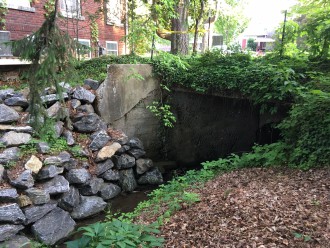
A sizable stone culvert under Edwin Place dates to the early 20th century, when the neighborhood was originally developed. That culvert could be collapsing, said Stephen Sands of consultants Hazen and Sawyer during an April 4 community meeting. The city, he noted, plans to spend $1.2 million over the next year or so to resolve the problem.
Gray vs. green
When designing such projects, the city is guided by several key concepts, Sands told the 60 or so residents who attended the meeting at St. Mary’s Episcopal Church on Charlotte Street. Regulations, he explained, prohibit any measures that would “increase flooding on downstream systems.” That means simply replacing a small pipe with a larger one is not an option.
The federal Clean Water Act also requires cities to keep sediment, fertilizer and toxic substances such as motor oil and pesticides from washing into streams and rivers.
To meet these requirements, planners are increasingly incorporating green infrastructure into stormwater designs to reduce the amount of water that pipes and culverts have to handle. Green solutions also filter the water and reduce pollution.
In the case of the Edwin/Celia project, designers are hoping to create “bioretention cells” — depressed areas with plantings where water can collect and slowly soak into the ground. These features could be installed on existing parkland along Celia Place, and the city, noted Sands, wants residents’ input on how they should look.
A pipe, he said, “is underneath the ground, and you would never know it’s there. These you will be seeing, and it will be integrated into the landscape.”
A ravine that runs through a grassy center strip on the adjacent Sunset Parkway already functions as a type of green infrastructure, slowing down the runoff as it passes over rocks and vegetation. Upgrades could improve its effectiveness, said Sands.
Despite some concerns about how the proposed green infrastructure would be maintained, neighbors expressed broad support for the idea of using natural features to reduce flooding and improve water quality.
Construction should begin this fall, Sands told residents. And once that infrastructure is in place, improvements aimed at reducing flooding on nearby Canterbury Road will begin. Together, the two projects are expected to cost about $2 million.
As above, so below
Several residents who attended the Grove Park neighborhood meeting argued that the impact of new development on the slopes of Sunset Mountain hasn’t gotten enough attention.
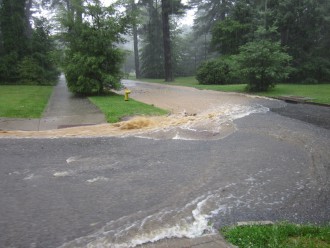
“For those of us who’ve lived in the area for 30 years, we haven’t had the level of flooding we’ve had in the last two or three years,” noted local architect Jane Mathews. “Are we really solving the problem by doing this, or is there something that’s happened above us that’s causing us to now, all of the sudden, have flooding?”
Meanwhile, Alan Escovitz, past president of the Grove Park-Sunset Mountain Neighborhood Association, said some other city priorities conflict with its stormwater goals. “The city is pushing very hard right now — and will be pushing in the next several years — to do more infill development,” he pointed out, predicting that planned development at the top of Sunset Drive, and the associated tree removal and grading, will add to the growing stormwater problems.
“Where is the water going to go?” he asked.
Council member Mayfield shares those residents’ concerns, saying the city needs a tougher stormwater ordinance. “The rule should be you are not allowed to increase or change the stormwater runoff from the property you’re developing,” she argues. “It may increase the cost of development, but we cannot be allowing private individuals to externalize their stormwater issues to their downstream neighbors.”
The trick, says Ball, the city’s top-ranking engineer, is to find the right balance of several priorities: addressing the stormwater problems, protecting property owners’ rights and keeping development (and, therefore, housing) affordable. Currently, she points out, commercial developers and those creating subdivisions must meet stormwater mitigation requirements. But people building individual single-family homes must comply with stormwater regulations only during construction, when “They have to get erosion storm permits and put up silt fences.”
According to the city’s code, developers must install measures that “retain the sediment generated by the land-disturbing activity within the boundaries of the site during construction.” In practice, however, those control measures frequently fail, triggering complaints and enforcement issues.
Communication breakdown
Sunset Drive resident Mark deVerges says stormwater draining from a construction site uphill from his house has deposited mud on his patio and driveway for more than a year — yet no one’s fixed the problem.
“We have had a year of agony dealing with continued failures to contain runoff due to poorly mitigated and poorly maintained silt fences,” deVerges wrote in a May 12 email to city employees.
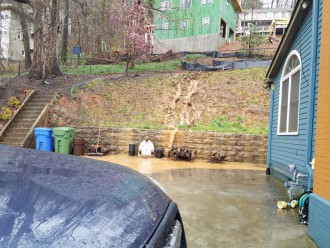
On May 23, the city issued a notice of violation to Mark Ledyard, who’s having a house built on a lot he owns at 21 Skyview Place. Ledyard’s contractor, Dan Thurman, said his first official contact with the city regarding this issue came on May 18 and that the required changes to the site’s silt fences were completed by lunchtime on May 19. Nonetheless, he continued, “We had a glitch the next day” during a rainstorm. Overall, said Thurman, “We’ve been as responsive [to the complaints] as we can,” noting that deVerges has a “very steep and poorly vegetated slope behind his house.”
On May 25, however, deVerges said the mud has kept washing down and “still sits behind our house,” adding that he’s not sure how best to proceed, since none of the options — suing his future neighbor, removing the mess himself or paying to have it cleaned up — seem desirable.
At an elevation of 2,390 feet and with an average slope of nearly 33 percent, 21 Skyview Place lies within Zone B of the city’s steep slope ordinance, which covers the highest elevations.
The city stormwater staff he’s interacted with, says deVerges, “have all been great,” but “There are not enough of them, and they seem very limited in their ability to maintain any level of meaningful enforcement.” Property owners have 30 days to address a violation before a fine can be issued.
In the works
Assistant Planning Director Alan Glines says proposed code changes include measures to limit the amount of impervious surface area a residential lot can contain. The changes, which have not yet been reviewed by the Planning and Zoning Commission and City Council, are motivated by Council members’ desire to encourage small-scale residential infill development to ease the city’s housing shortage and create more affordable housing.
If approved, the changes will reduce the minimum lot area and width in all residential districts by 20 percent. According to a staff memo presented to Council’s Planning and Economic Development Committee on May 16, “This change would help residential districts get closer to reaching allowable densities, which for the most part are not being met.” This, the memo continues, could create as many as 10 percent more developable parcels throughout the city. The changes would also allow up to 12 multifamily units in residential districts, provided that, for each additional unit, the lot is at least 1,000 square feet bigger than the required minimum size.
The changes also establish a maximum amount of area that can be covered by structures, driveways, paving or gravel in all residential districts. Those measures, says Glines, were incorporated into the new lot size standards to address residents’ concerns about the potential impact of denser development on stormwater. This is important, he explains, “because we don’t have anything on the books now.”
When it rains, you pay
Not everyone is likely to greet expanded stormwater regulations with open arms, however. Some city residents still grumble about the existing stormwater fee, which was levied in 2006.
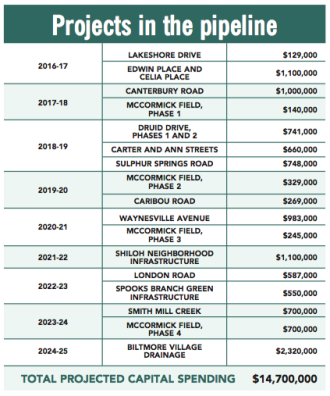
In a 2015 debate about a $74 million bond referendum that was subsequently approved by voters, Chad Nesbitt, a former chair of the Buncombe County Republican Party, derided the city’s largely Democratic leadership for its track record on maintaining Asheville’s infrastructure. When City Council spends money on things it’s not legally responsible for, said Nesbitt, it has to “make a bond referendum and crazy things like a rain tax” to fund essential items. “The city of Asheville,” he continued, “literally charges homes and businesses for the rain that hits your roof.”
Asked by Mayor Esther Manheimer how he would pay for maintaining stormwater infrastructure if not through a dedicated fee, Nesbitt said it should be financed via property taxes.
Former City Council member Carl Mumpower says the stormwater program, created back in 2006, “was long on education, bureaucracy and planning — short on real action to solve our stormwater issues.” Mumpower, who now chairs the Buncombe County Republican Party, says he cast the lone dissenting vote against the program.
Where stormwater is concerned, Mumpower maintains, the biggest bang for the buck comes from “incentives that help developers mitigate the water falling on their property,” repeating “on their property” to drive home his point.
Legal complications
As with most policy issues related to development, notes Mayfield, state law may limit what the city can require individual property owners and small-scale residential developers to do in the name of stormwater management. At the same time, she continues, because stormwater affects the city’s compliance with the Clean Water Act, “The state has much less to say about stormwater management than they do in other areas.”
Besides revisiting its stormwater ordinance, Asheville needs to come up with a better way to monitor such problems and concerns, says Mayfield. The city’s Sustainability Advisory Committee on Energy and the Environment, she points out, has called for a dedicated committee to deal with these matters. A city committee established six years ago to hear appeals of stormwater violations and fines has never met, since no appeals have been filed.
In February, City Council’s Boards & Commissions Committee discussed the possibility of creating a new entity to advise Council members on these issues. But while Mayfield says it was decided to convene a stakeholder group to discuss stormwater issues in about six months, Ball says city staff merely agreed to come back in six months with a plan for convening such a group.
In other words, don’t hold your breath.
Logistical issues
In the meantime, features such as rain barrels, rain gardens, swales and permeable surfaces can enable homeowners to disconnect their downspouts from the city’s stormwater system. And giving them incentives to do so sounds like a great idea — until you consider the logistics of administering such a program, Ball and others say.
Any city rebate program must be fair and accountable, notes Ball. And because most green stormwater measures require ongoing maintenance to work properly, she continues, overseeing an incentive program might cost the city more than it would save.
Permeable alternatives to pavement are a good example. When gravel becomes compacted enough to drive on, “It doesn’t drain as much water as you might think,” she explains. And systems that combine paving blocks with gravel don’t work as well once silt and other debris begin to clog the spaces that allow the water to flow through. “To function properly, these systems require pressure-washing on a regular basis,” says Ball. “For the city to try to oversee that maintenance to provide a fee rebate or an incentive would really be a big undertaking.”
That doesn’t mean the city doesn’t appreciate residents’ efforts to reduce the load on the stormwater infrastructure, staffers say, but don’t expect to get a fee waiver.
Another way residents can help is by keeping an eye out for clogged storm drains and perhaps volunteering to help tackle problem areas. Last June, for example, Asheville GreenWorks and the Historic Biltmore Village Association joined forces to remove tree trunks and other debris from Sweeten Creek to improve the stream flow. And even if you can’t clean out a clogged drain yourself, city staffers say, it’s helpful to report the issue by using the Asheville App or calling Stormwater Services (see sidebar, “Troubleshooting Stormwater Problems”).
Borrow and spend?
In 2016, Asheville adopted a 10-year capital improvement plan for 18 high-priority stormwater projects throughout the city, with a total estimated cost of nearly $15 million.
An additional seven projects with a combined price tag of over $5 million are also noted in the plan. All such projects, stresses interim Stormwater Services Director Amy Deyton, will be re-evaluated every year, so the priorities may change. At the moment, though, the Wellington Street project doesn’t appear on either list.
Considering the scope of the problems, says Mayfield, “We’re not going to get ahead of this unless there’s some fabulous new federal or state grant for stormwater infrastructure.” But as with other city needs such as public transit and subsidized housing, it’s probably not realistic to expect outside funding to be a silver bullet. “Money is scarce everywhere,” she says.
And while people can get behind bonds to finance parks, affordable housing or transportation, Mayfield points out, “Nobody’s going to get excited about a bond for stormwater.” Nonetheless, she maintains, “That may be where we’re headed.”
Meanwhile, over on Wellington Street — and probably on many other streets around town — Nina Hart says, “We all just kind of panic when it rains.”



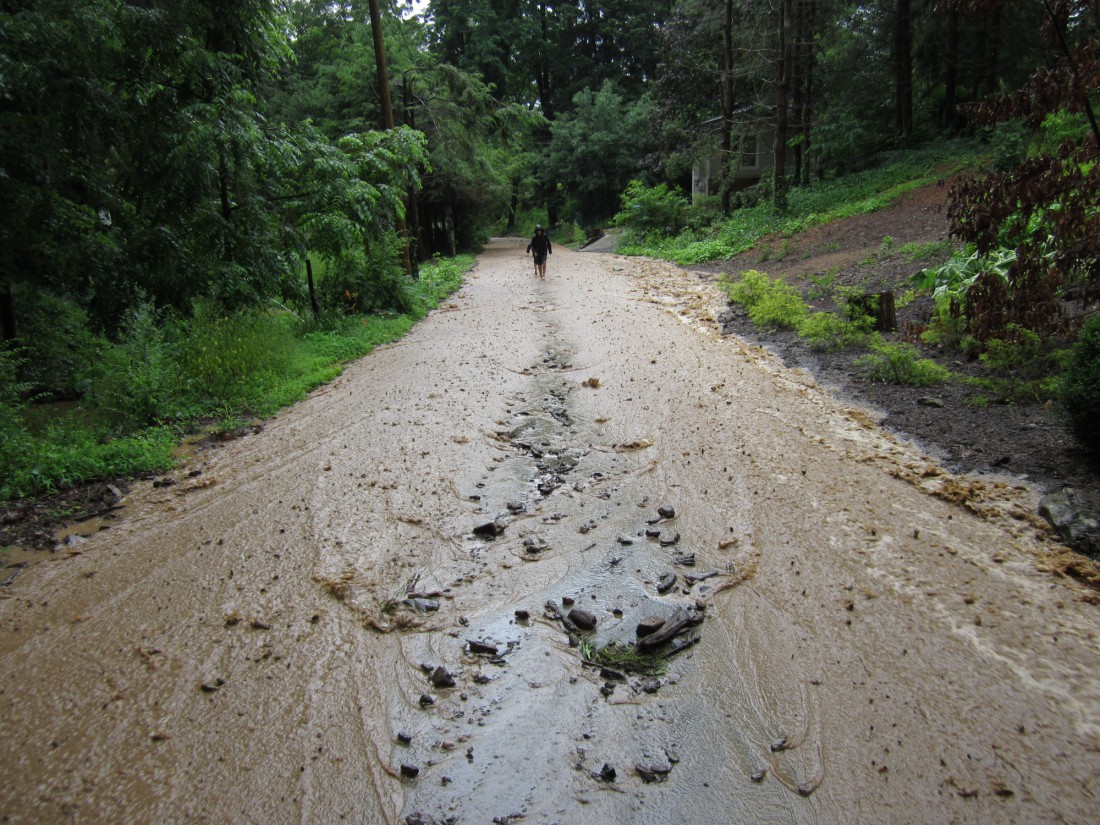
“Here in Asheville, however, climate change is only one factor driving a rising tide of stormwater problems. ”
Other than the minor detail it is easy to verify that statement is not accurate. Here’s the rain data… see for yourself, before believing false information.
1972 16.85
1973 122.23
1974 73.51
1975 59.53
1976 63.6
1977 52.46
1978 38.39
1979 55.23
1980 39.27
1981 33.55
1982 53.7
1983 58.46
1984 50.34
1985 38.98
1986 33.97
1987 42.41
1988 26.22
1989 59.81
1990 55.72
1991 42.69
1992 57.21
1993 41.7
1994 60.77
1995 130.14
1996 79.58
1997 47.48
1998 47.55
1999 39.15
2000 23.19
2001 34.31
2002 41.88
2003 56.14
2004 51.07
2005 47.14
2006 48.04
2007 34.39
2008 35.6
2009 62.14
2010 44.26
2011 46.05
2012 44.52
2013 75.31
2014 46.91
2015 53.37
2016 31.01
Here’s the temperature data… see for yourself. It’s actually down in our area.
1948 37
1949 43
1950 52
1951 57
1952 57
1953 39
1954 46
1955 68
1956 37
1957 46
1958 39
1959 52
1960 50
1961 30
1962 34
1963 42
1964 61
1965 53
1966 33
1967 50
1968 37
1969 32
1970 46
1971 57
1972 52
1973 45
1974 60
1975 35
1976 45
1977 48
1978 48
1979 44
1980 28
1981 37
1982 62
1983 14
1984 54
1985 26
1986 48
1987 64
1988 51
1989 28
1990 39
1991 51
1992 50
1993 37
1994 42
1995 34
1996 42
1997 55
1998 33
1999 34
2000 36
2001 41
2002 39
2003 37
2004 35
2005 49
2006 50
2007 49
2008 58
2009 40
2010 34
2011 46
2012 50
2013 38
2014 48
2015 67
2016 64
Thanks, Mark, for that comparative information.
What the National Climate Report was commenting on was rain intensity rather than total rainfall, i.e., the volume of rain received in short, intense periods. During these more intense storms, the rain doesn’t have time to soak in and runs off, creating more strain on the stormwater infrastructure, more erosion, more sediment in the runoff, more localized flooding and other problems.
“What the National Climate Report was commenting on was rain intensity rather than total rainfall,”
So how did the assessment account for the differences in technology and measurement before 1964? How did the assessment account for the impact of Doppler Radar?
Let me save you the time… it did NOT.
“During these more intense storms, the rain doesn’t have time to soak in and runs off, creating more strain on the stormwater infrastructure, more erosion, more sediment in the runoff, more localized flooding and other problems.”
And where does this “stormwater infrastructure” exist? Out in the country, or maybe, just maybe… in the city?
Here’s the temperature data… see for yourself. It’s actually down in our area.
1948 37
1949 43
1950 52
1951 57
1952 57
1953 39
1954 46
1955 68
1956 37
1957 46
1958 39
1959 52
1960 50
1961 30
1962 34
1963 42
1964 61
1965 53
1966 33
1967 50
1968 37
1969 32
1970 46
1971 57
1972 52
1973 45
1974 60
1975 35
1976 45
1977 48
1978 48
1979 44
1980 28
1981 37
1982 62
1983 14
1984 54
1985 26
1986 48
1987 64
1988 51
1989 28
1990 39
1991 51
1992 50
1993 37
1994 42
1995 34
1996 42
1997 55
1998 33
1999 34
2000 36
2001 41
2002 39
2003 37
2004 35
2005 49
2006 50
2007 49
2008 58
2009 40
2010 34
2011 46
2012 50
2013 38
2014 48
2015 67
2016 64
When providing data, it would be helpful to include an explanation of the data. Otherwise, it’s just a bunch of numbers without context, preventing anyone from understanding what you are trying to express.
LOL… if you can’t figure out the below, there was never any hope for you.
Here’s the temperature data… see for yourself. It’s actually down in our area.
1948 37
1949 43
Wow thanks for insulting someone with an honest question and attempting to help you communicate your ideas. That’s really rude and a classless move. And you still did not explain what the temperature data represents! It’s obvious there is a year then some number….but what is this number? Average temperature for the entire year? High temp? Low temp? Number of days with record high temperature? You see, there are lots of ways to measure and convey data about weather. But just listing a number without context is ignorant if you expect someone to know what you’re talking g about.
What comes around goes around…
You’re right. Someone who really wanted to honestly inform the discussion would have, at the very least, given a link to where the “data” came from. That way, people could know where it came from, how it was collected, what it was referring to, etc. But “honestly informing the discussion” isn’t always the reason people post here, is it?
1959 57
2002 -3
2175 73
There, see? I can do it too…
“Wow thanks for insulting someone with an honest question and attempting to help you communicate your ideas.”
LOL… had you wanted to help, you would have just asked for some details. That’s not what you did now, is it?
“That’s really rude and a classless move. ”
Nah, you were rude by not actually asking a question for clarification, but trying to lecture. Had you wanted to truly know and engage in conversation… you would have just asked. You didn’t. I suspect that was because you wanted to distract from what the data actually shows.
“And you still did not explain what the temperature data represents!”
I assumed people would exercise common sense. My bad.
“It’s obvious there is a year then some number….but what is this number?”
Temperature data. Which is what I said before.
“Average temperature for the entire year? High temp? Low temp? Number of days with record high temperature? You see, there are lots of ways to measure and convey data about weather.”
Ah, so NOW you are actually asking a question and not lecturing. I’ll forgive your rude behavior. However, I am about 100% sure you already know the answer… since I never mentioned anything about highs or lows.
You are being intentionally obtuse and you know it.
“But just listing a number without context is ignorant if you expect someone to know what you’re talking g about.”
I expected
What comes around goes around…
“Someone who really wanted to honestly inform the discussion would have, at the very least, given a link to where the “data” came from.”
It’s from Weather Underground. All anyone had to do was ask.
“That way, people could know where it came from, how it was collected, what it was referring to, etc.”
All you had to do was ask. Weather Underground.
“But “honestly informing the discussion” isn’t always the reason people post here, is it?”
But I did. The data clearly shows that the comment I highlighted is bogus.
“1959 57 2002 -3 2175 73 There, see? I can do it too…”
Right, but my data is real and was a full record of data. ; – )
Does anyone else notice that Mr. Cates still hasn’t explained what those numbers mean? Sure – a year, and then a temperature. What? What does it represent? Please try not to insult us this time, and just give a straightforward response.
Awww, cut the man a little slack. He’s living in “the heart of enemy territory,” after all.
That’s why he has to write in code.
“That’s why he has to write in code.”
I guess that’s his way of “striking a blow from the inside.”
“These days, when it rains, it really pours.”
It’s clear in the data that statement is meaningless.
No, it isn’t. https://www.theguardian.com/environment/2011/dec/15/climate-change-rainfall.
From the US Geological Survey…
“Only one of four large regions of the United States showed a significant relationship between carbon dioxide (CO2) in the atmosphere and the size of floods over the last 100 years. This was in the southwestern region, where floods have become smaller as CO2 has increased.”
Say what? Floods are smaller where Co2 has increased?
“Of course, human activities within the watershed can also have a major influence in the size of floods. These include urbanization, building of dams and levees, and shifts in vegetation types and drainage of soils and wetlands. At the present time, we see much larger changes in flooding from these causes than we can see from greenhouse forcing.”
Like stormwater infrastructure in a… city.
Or the lack of preparation because tax money is being funneled to cronies and developers. And the irony being that these developers are building on flood plains and expect us to bail them out after the next major flood.
The term is “GLOBAL” Warming, not United States warming. Your “data”, again, is utterly meaningless.
Anyway, I hear that renowned scientists Donald Trump and Bashar al-Assad both say that climate change is hooey.
Anyway, I hear that renowned scientists Donald Trump and Bashar al-Assad both say that climate change is hooey.”
LOL… I put up data, you don’t. All you appear to have is hate for Trump.
LOL they have contempt for anyone that disagrees. And of course refuse to admit that Newman is a what they assume is a Trump. The local crony who became rich off the backs of taxpayers.
You have nothing but contempt for everyone here. $75 separates you from cowardice.
LOL running from facts only keeps you ignorant. And a city who proudly displays signs with no Muslim ban on its doors in the midst of people being ran over or blown up in the UK is is way above in that regard. Newman is a crook. People who stand by while he enriches himself are lacking in substance and any ability to rationalize.
“People who stand by—”
$75. Filing closes on July 21. We’ll judge you by your own standards.
You put up random numbers, refusing to explain what they mean or post a link to where they came from. I’m going to assume you made them up.
Fair.
Is stormwater management, per Carl Mumpower, something that should be addressed by “incentives” to individual property owners, where if a rich landowner on a slope wants to flood your house, you’ll just have to find the money to sue him, or through regulation and planning on a broad local level?
That matters more than copy-pasta.
LOL so we should bail out 12 Bones after the next flood? Is that during or after their month long vacation? Better yet, let’s just give them new infrastructure while the rest crumbles. And Bothwell gets his park for tourist.
Unresponsive. Off-topic. Try again instead of the usual froth. Is stormwater management something that should be entrusted to individual property owners, per Mumpower, or does it need to operate in a broader regulatory framework?
LOL no it’s not. Considering the huge amount of subsidizing in the RAD, the expectation of a bailout after another major flood is ensured. Again, storm water fees are diverted to the general fund. The city uses these fees not for improvements but a slush fund. And an ignorant city votes in more debt instead of demanding that their money is spent wisely.
Better yet why after 10 years of storm water fees is the system not only in disrepair, but a bond was introduced to fix it? Why is the media not asking these questions? These cronies need to be held accountable. If the water and storm water system are different n such directly straits, why are we funding things that are not important?
In dire straights.
The city budget is a public document. Try again instead of sounding like a doll that coughs out one of five responses when you pull the string.
Carl Mumpower thinks that stormwater management should be achieved by “incentives that help developers mitigate the water falling on their property.” Do you agree?
Are you kidding me about climate change ? Give me a break ! This is about the fact that the city of Asheville allowed the side of mountains to be over built with the “Snow bird” invasion of every one moving here thinking it’s the center of the earth. Now they are crying because the water has no where to flow. Oh no ! Cry all you want, you did it to yourselves. Run to your little safe spaces in your 10,000 sq. ft. homes, and cry and they slide off the side of the mountains.
Honestly, I was looking to build/purchase in Asheville but then realized how much property was available and wondered how it must affect infrastructure. I’m originally from Florida and saw first hand how quickly things go wrong when development/money gets ahead of all other aspects of growing a community, and it’s bad. Really bad. Not to mention expensive to fix, if at all possible.
So I did a bit of research and ended up here. Although I believe climate change is a real and serious problem, I find that in this case it’s more of a development issue. No thought has gone into the consequences of building up the space and now old and new residents are paying the price, while developers move on to the next town to destroy.
Needless to say, you have a beautiful town, but one that I would avoid moving to. I’m sure the rain is not your only issue arising after so much has been done…and continues to be done.
How unfortunate.
The data needs clarification and documentation if it is to be of any use. Most importantly, is the location of the collection itself. Was this done downtown or at the airport?Was it the same site, for all of the years listed? Simply listing data does not make a point let alone win an argument. Remember what we learned in high school about footnoting?
If you’re referring to the long list of supposed temperature numbers posted above, it appears to me to have been made up.
just remember…we have the most pathetically run city in the country …we have a total lack of leadership, ongoing now for decades…
strive to be smarter than the nasty ‘progressives’ want you to be for they are EVIL.
Still time to get your name on the ballot, Fred Caudle.